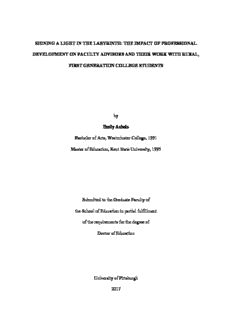
the impact of professional development on faculty advisors and their work with rural, first ge PDF
Preview the impact of professional development on faculty advisors and their work with rural, first ge
SHINING A LIGHT IN THE LABYRINTH: THE IMPACT OF PROFESSIONAL DEVELOPMENT ON FACULTY ADVISORS AND THEIR WORK WITH RURAL, FIRST GENERATION COLLEGE STUDENTS by Emily Aubele Bachelor of Arts, Westminster College, 1991 Master of Education, Kent State University, 1995 Submitted to the Graduate Faculty of the School of Education in partial fulfillment of the requirements for the degree of Doctor of Education University of Pittsburgh 2017 UNIVERSITY OF PITTSBURGH SCHOOL OF EDUCATION This dissertation of practice was presented by Emily Aubele It was defended on March 31, 2017 and approved by Dr. Jill Perry, Research Associate Professor, Administrative and Policy Studies Dr. David Lott, Associate Professor, Clarion University of Pennsylvania Dissertation Advisor: Dr. John Weidman, Professor of Higher and International Development Education, Administrative and Policy Studies ii Copyright © by Emily Aubele 2017 iii SHINING A LIGHT IN THE LABYRINTH: THE IMPACT OF PROFESSIONAL DEVELOPMENT ON FACULTY ADVISORS AND THEIR WORK WITH RURAL, FIRST GENERATION COLLEGE STUDENTS Emily Aubele, Ed.D University of Pittsburgh, 2017 The purpose of this Action Research study was to investigate the impact of the first iteration of a training and development program for faculty academic advisors. The program intends to assist faculty advisors to enhance and refine the academic advising strategies they employ when working with first generation, rural college students at Clarion University’s Venango Campus. This study first explored, through focus groups, the experiences and perceptions of faculty advisors and first generation rural college students related to academic advising. Findings from that exploration served as a basis for the development and implementation of a campus specific academic advising training and development program for faculty, with an emphasis on the advising and self-efficacy needs of the first generation, rural college student. The study found that advisors who have access to training and development opportunities, and institutional support for their advising work with students are better able to employ developmental advising approaches that help to successfully guide the first-generation, rural college student through the transition to the academic environment. Faculty advisors who do not receive regular training and development, or are unclear as to the institutional advising iv philosophy, struggle to provide advising services that extend beyond the prescriptive and may feel underprepared to help students transition successfully. v TABLE OF CONTENTS PREFACE ..................................................................................................................................... X 1.0 INTRODUCTION ........................................................................................................ 1 1.1 PURPOSE OF THE STUDY .............................................................................. 2 1.2 PROBLEM OF PRACTICE ............................................................................... 3 1.3 SIGNIFICANCE OF THIS STUDY .................................................................. 5 2.0 REVIEW OF THE LITERATURE ............................................................................ 7 2.1 THEORETICAL FRAMEWORK ..................................................................... 7 2.2 RURALITY .......................................................................................................... 8 2.3 FIRST GENERATION COLLEGE STUDENTS AND RURALITY ............ 9 2.4 SELF-EFFICACY ............................................................................................. 12 2.5 ADVISING AND FIRST GENERATION COLLEGE STUDENTS ............ 17 3.0 RESEARCH DESIGN ........................................................................................................ 21 3.1 APPROACH ....................................................................................................... 21 3.2 EXPLANATION OF POSITIONALITY ........................................................ 22 3.3 CONTEXT.......................................................................................................... 23 3.4 METHODOLGY ............................................................................................... 25 3.5 FOCUS GROUPS .............................................................................................. 26 3.6 TRAINING EVALUATION ............................................................................. 27 vi 3.8 THE TRAINING PROGRAM ......................................................................... 28 3.8 DISCUSSION OF OBJECTIVES .................................................................... 29 3.9 DEFINE THE NEEDS OF FIRST GENERATION AND NON- TRADITIONAL STUDENTS AT VENANGO ............................................................... 30 3.10 IDENTIFY YOUR PERSONAL ADVISING PHILOSOPHY ...................... 32 3.11 REVIEW FOUR ADVISING MODELS ......................................................... 35 3.12 ACQUIRE TOOLS AND STRATEGIES FOR USE IN ADVISING AND GOAL SETTING MEETINGS WITH STUDENTS ...................................................... 35 4.0 FINDINGS .................................................................................................................. 37 4.1 INTRODUCTION ............................................................................................. 37 4.2 DISCUSSION SUMMARY ............................................................................... 37 4.3 EVALUATION SUMMARY ............................................................................ 42 4.4 RECOMMENDATIONS .................................................................................. 47 4.5 LIMITATIONS .................................................................................................. 48 5.0 CONCLUSION ........................................................................................................... 50 APPENDIX A .............................................................................................................................. 52 APPENDIX B .............................................................................................................................. 58 APPENDIX C .............................................................................................................................. 60 BIBLIOGRAPHY ....................................................................................................................... 72 vi i LIST OF TABLES Table 1 Themes and Objectives .................................................................................................... 29 Table 2 Concerns and Interventions ............................................................................................. 42 viii LIST OF FIGURES Figure 1 Research Cycle ............................................................................................................... 22 Figure 2 Powerpoint Presentation ................................................................................................. 71 ix PREFACE I would like to thank the following individuals for the support, inspiration, and encouragement they provided to me throughout this process: Dr. Renee Bloom and Dr. Ellen Foster for taking time out of their crazy schedules to read my first draft and help construct it into something I could stand by, and ultimately upon which I could build the whole project. Dr. Dave Lott, who served on my committee and got me through the last few weeks with his sage commentary: "Well, it's too late to worry about that now!" I will be forever grateful for his guidance and his confidence. Julia Samspon, Erin Shuetz, and Susan Donat-for keeping me Westminster strong. Jayne Shord for her constant encouragement. Sandy Aubele, Matthew Aubele, and Hunter and Cooper Aubele, for being my cheerleaders. My grandparents, Martin and Emma Chew, who always demonstrated the importance of hard work and perseverance. Linda Aubele, I wish you had been able to be here for this. Almost finally, Tammy Dulaney and Olivia, Elizabeth, and Alexis Beach- if not for all of you, your patience, your belief when I had little, your encouragement, your love-I don't know if this would have been possible. You are my people, and I am forever yours. And finally, Gil and Diane-mom and dad-this accomplishment is totally and completely yours. Thank you so very much for every single sacrifice you made, (which were many) because you believed that someday this would happen. x
Description: